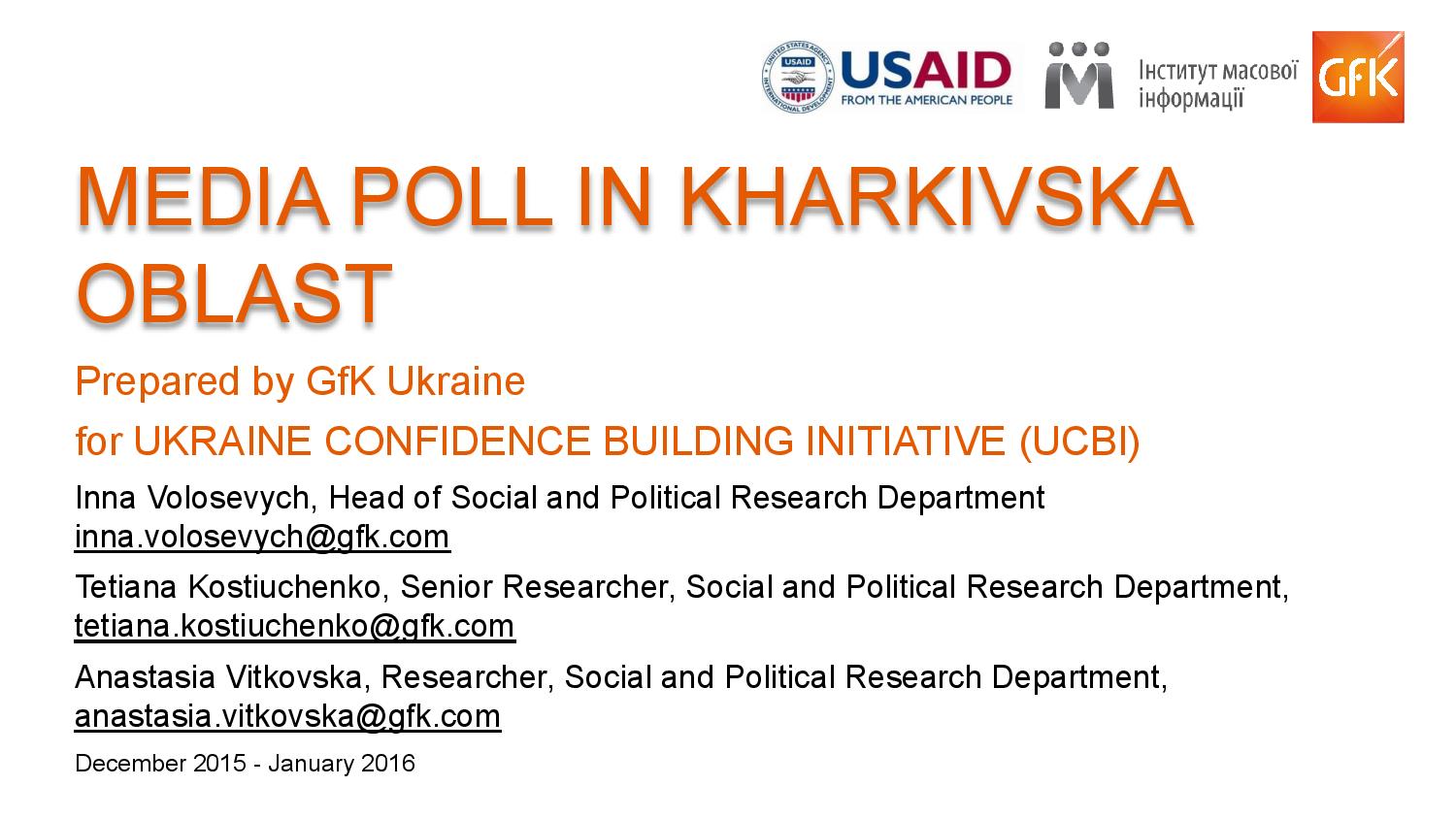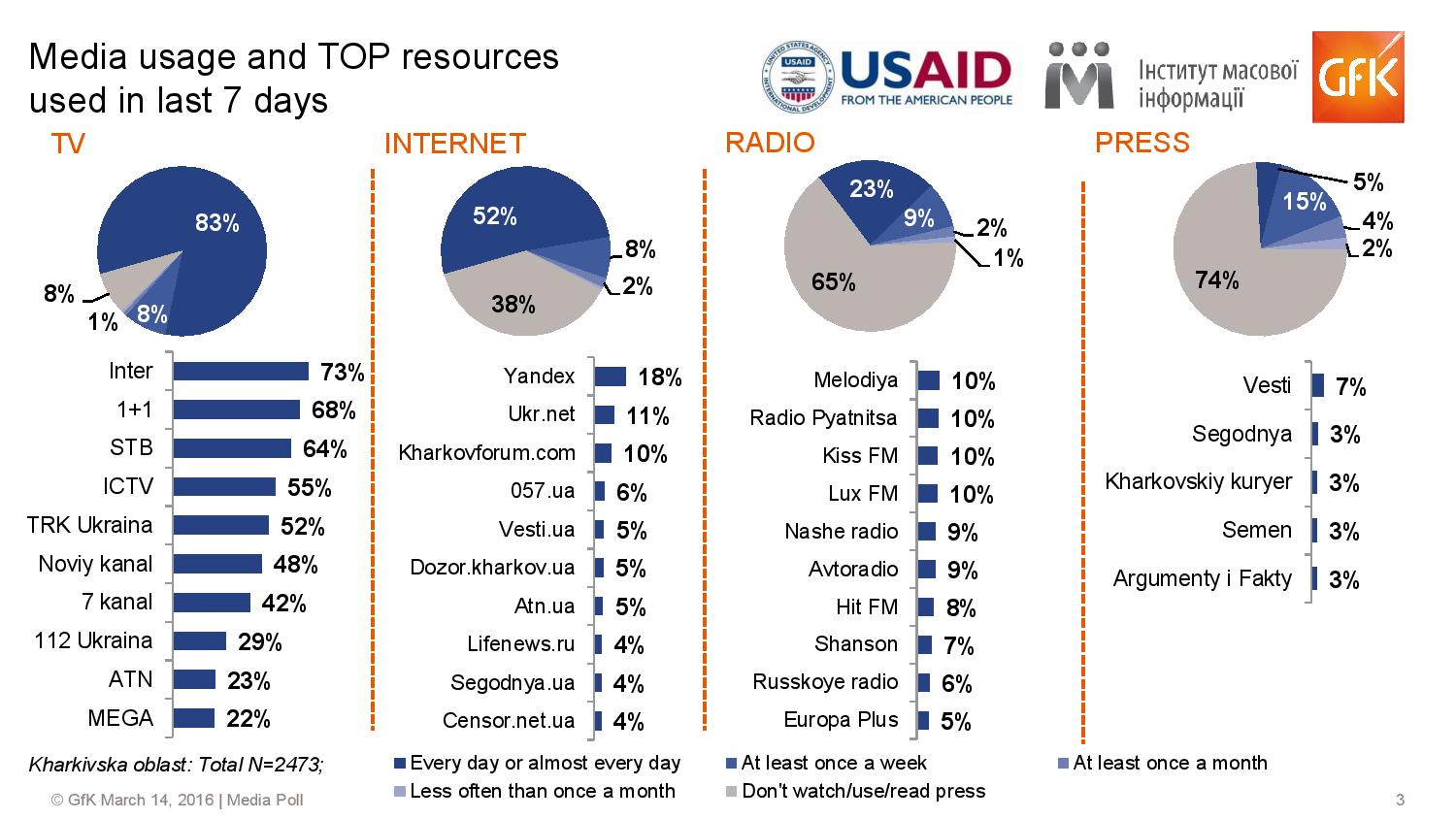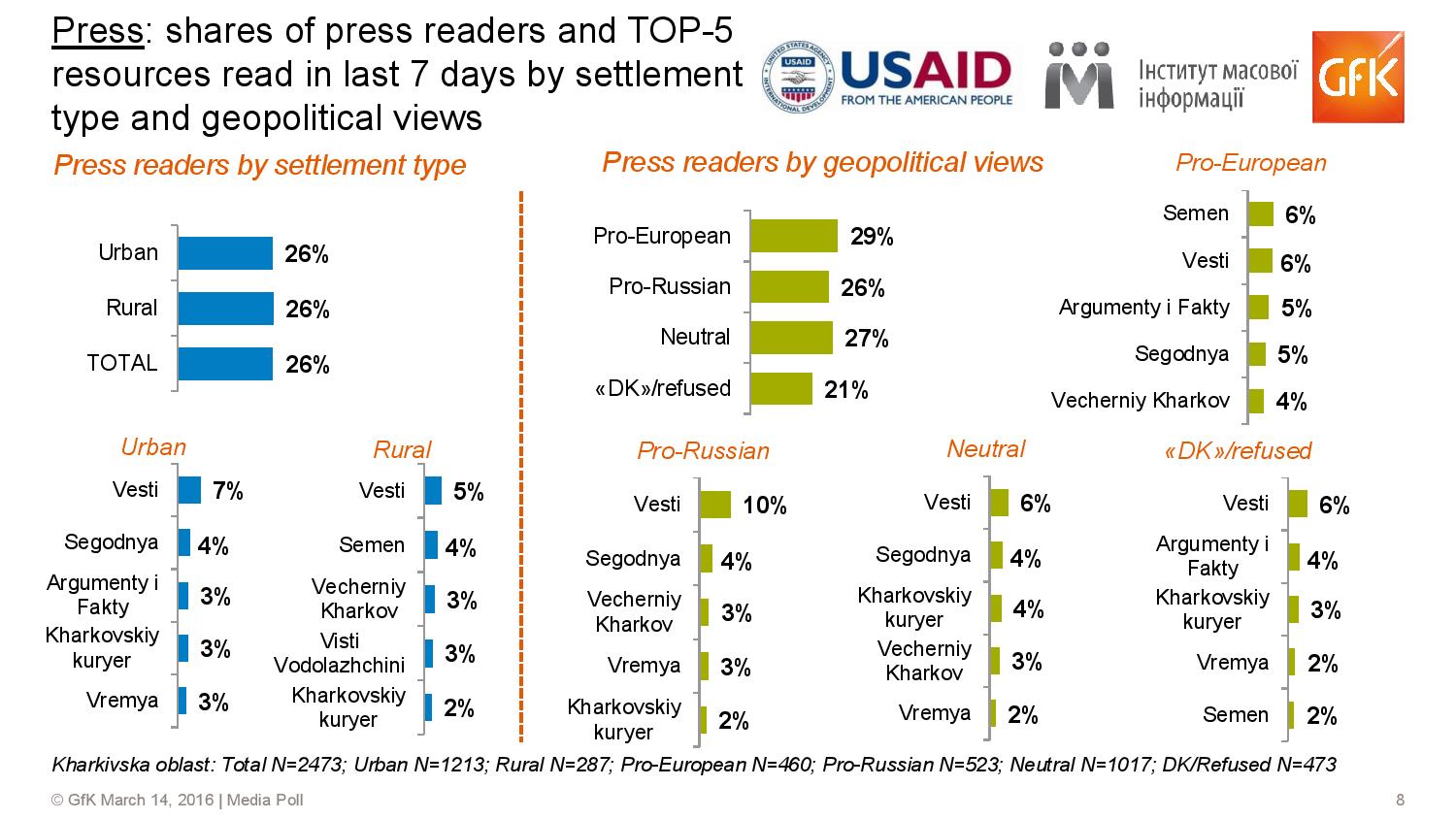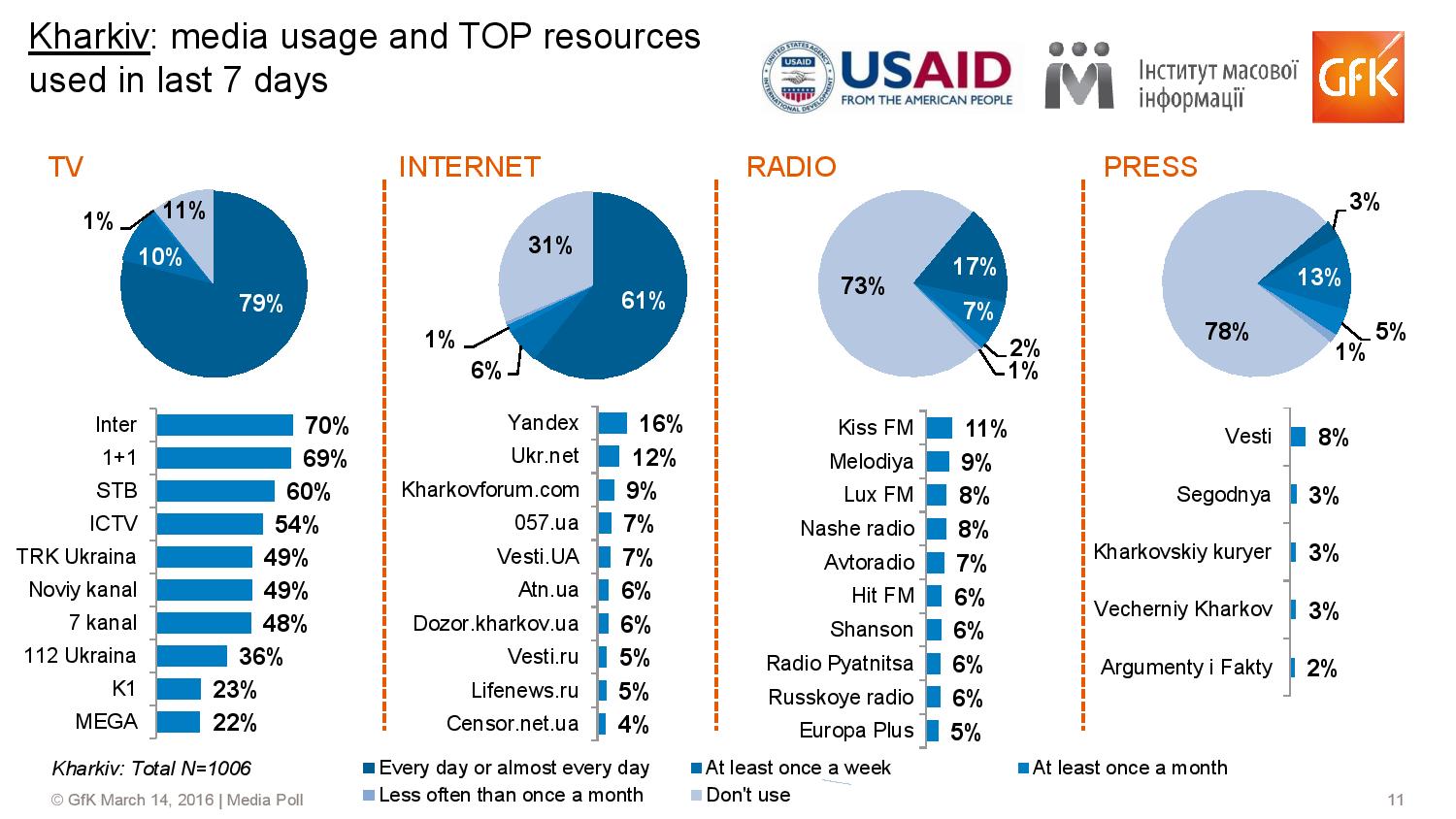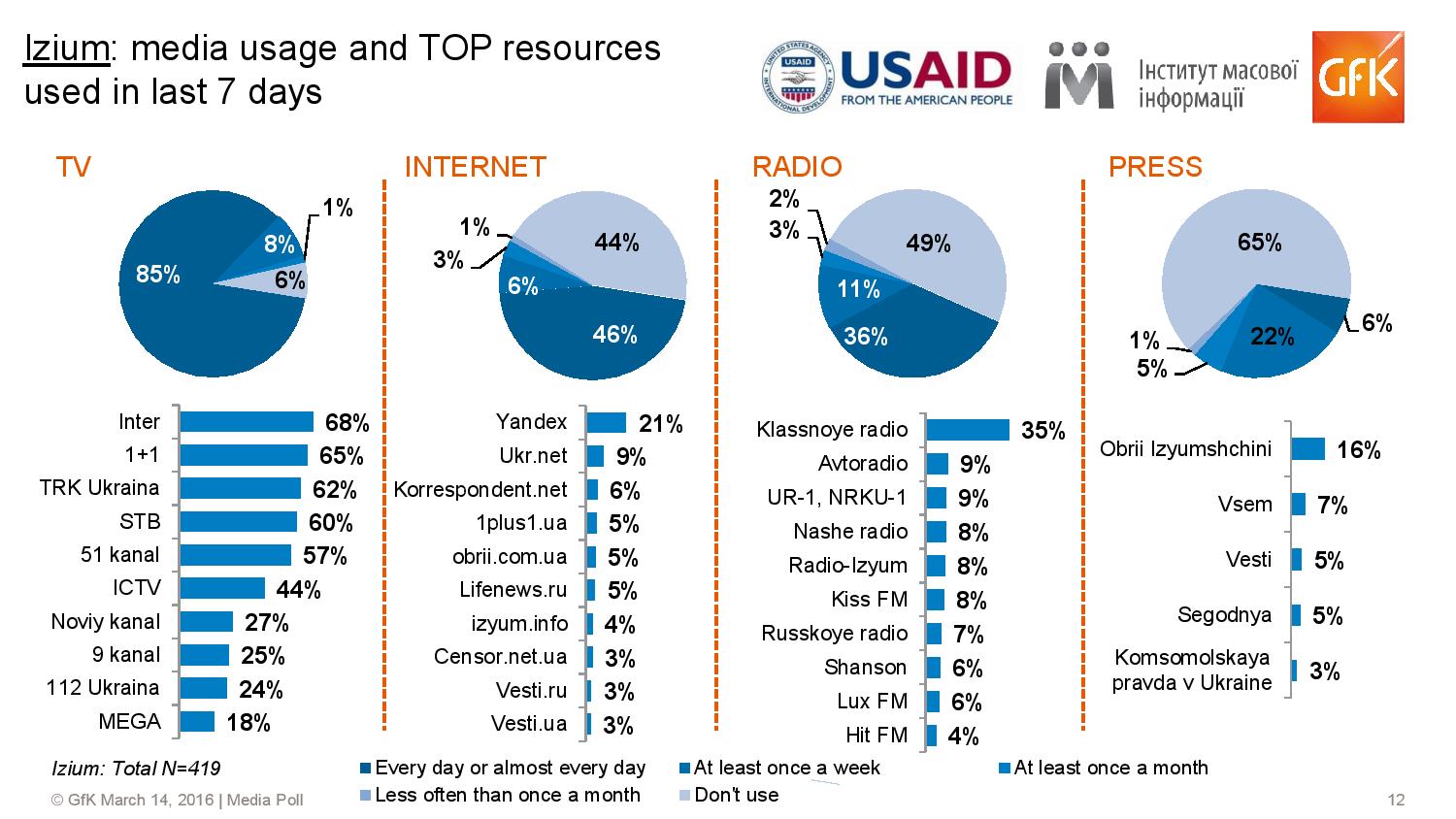Analysis by Institute of Mass Information
MAIN TENDENCIES OF MEDIA SPACE
In Kharkiv, with its population of one million persons, there is no local radio, and the city also lacks printed media outlets, and the available newspapers and TV channels quite often belong to well-known Ukrainian politicians, businessmen, and their proxies. In this aspect, Kharkiv media market is not unique – here, just like in the rest of Ukraine, mass media is not a business, it is an opportunity to broadcast the politicians’ opinions. They try to «buy» even some independent media outlets that have been emerging in the last two years.
In Kharkiv itself, there are 10 local TV channels: A/TVK, OTB, Channel 7, Simon, «Fora», «Favoryt», and R1; all of them are traditionally used by the owners for self-advertisement.
There are 12 local informational websites; most popular of them are Glavnoe and 057.ua (more than 30 thousand users per day). All news websites are in Russian only, Ukrainian versions are not even available, the only exception is the resource Spravzhnia Varta («The Real Guards»), and the website Maidan, which is not updated that often and is designed mostly for the nation-wide audience. All other websites have the number of daily hits from 5 to 8 thousand per day, some even less.
Almost three million residents of Kharkivska oblast have only 86 various newspapers and magazines, of them 21 are communal media outlets. According to the data of Kharkivska Oblast State Administration, the most popular media outlets are: the news and entertainment weekly edition «Teleskop» and advertisement and news media outlets, such as «Premier Digest», «Kharkov na Ladoniakh», «Aviso». The third place in popularity rating of printed editions is held by newspapers about social and political issues «Vecherniy Kharkov», «Vremia», «Slobidskyi Krai», and local branches of national Ukrainian newspapers – «Komsomolskaya Pravda v Ukrainie. Kharkovskiy Vypusk», «Segodnia. Kharkov», «Vesti. Kharkovskiy Vypusk».
According to IMI data, in addition to traditional mass media types, mass media that are popular among Kharkiv residents are public aggregators of local news in social networks – they are «Khuyovyi* Kharkov» (*obscene word, loosely translates as «Fuc*ing Kharkov») and «IT sector Kharkov», scoring over 200 thousand users. For comparison, no other local printed or online media outlet has an audience this large.
Most local media outlets also have communities in social networks; yet, they are not that popular: at average they have about 2.5-3 thousand followers, even if they are constantly updated. Some media outlets are either just traditional mass media outlets or simply have «business cards» in social networks, with a minimal number of subscribers (from 200 to 500, like, for example, the web-page of Kharkiv Oblast TV (the branch of the National TV Company of Ukraine), or the local newspaper «Vremia»), or have neither communities in social networks nor websites of their own (like the TV and Radio Company «Fora», TV R1) – they still have Youtube channels, though.
MEDIA START-UPS
Among the newly created media outlets, the most popular are two communities in social networks – the above-mentioned Khuyovyi Kharkov (almost 130 thousand users in social networks, of them 125 thousand are VKontakte users) and «IT sector Kharkov» (approximately 70 thousand users in social networks). Both startups are aggregators of local news and re-posts on local topics in social networks. They have their distinct specificity, heavily loaded with obscene words; this can be rather called «community journalism». Their posts are often scandalous, they express their authors’ opinions, but at the same time, they are relevant and important for the local community. Still, due to lack of professionalism, validity of information provided by such communities is under question. Both of them are independent, prevalently use Russian language, yet center on Ukraine: there are patriotic posts in Ukrainian there, and criticism of local authorities. According to IMI data, «IT sector Kharkov» is financed by international donors (the Renaissance Foundation), sources of «Khuyovyi Kharkov»’ funding are unknown.
«Nakipelo» – a Youtube channel of volunteer journalism, the project of Kharkiv Crisis Media Center. For now, the project does not have a website of its own, the total number of social networks’ users subscribed to it is up to 10 thousand. Mainly, this channel broadcasts records of events from Kharkiv Crisis Media Center, yet there are some videos from volunteers on topical local issues.
Newsroom – another startup, which is an effort of local journalist Pavlo Fedosenko to create a fast-response multimedia outlet. The website is not registered as a media outlet. In fact, it was founded at cost of the founder's family, yet it does not measure up to the hopes vested in it: the resource did not acquire a considerable influence and periodically publishes «dzhynsa» (commissioned materials) in the interests of the former Party of Regions member, now co-leader of the party «Nash Krai», Oleksander Feldman.
Hromadske TV of Kharkiv appeared in 2015. The materials are produced not by professional journalists; some of the people who do it are IT specialists. This media outlet responds to events faster compared to traditional mass media outlets in Kharkiv.
«Kharkovskaya Nedelia» – an informational and analytical printed edition that appeared in Kharkiv during the elections campaign of 2015. The media outlet was registered on September 15, with the number of copies of 100 thousand. The newspaper positions itself as an independent analytical media outlet and publishes articles of well-known journalists – Yehor Checherynda, Filip Dykan, Oleksander Kostenko, with a minor share of materials biased to the benefit of «Samopomich». The newspaper is distributed for free. According to IMI sources’ data, the newspaper is affiliated with the local «Samopomich» and is supported by businessman, founder of the foundation «Peace and Order», Vsevolod Kozhemiako. According to its publication data, the newspaper is printed in the printing house «Faktor-Druk» owned by the co-founder of the foundation «Peace and Order», Serhiy Polituchyi.
LANGUAGE OF KHARKIV MASS MEDIA
90% of local mass media outlets are published in Russian, and they do not even have Ukrainian versions. Only communal mass media outlets are published in Ukrainian: for example, Kharkiv Oblast State Administration’s newspaper «Slobidskyi krai» or its TV station. Local television is also prevalently Russian-speaking, yet there are news programs in Ukrainian. The single Ukrainian-only resource in Kharkiv is the community journalism project «Spravzhnia varta». In 2007, it separated from the Ukrainian version of «Gorodskoi Dozor» («City Watch») and became independent. According to IMI sources, the project is financially supported by the Ukrainian Diaspora in the USA.
LOCAL MEDIA-OWNERSHIP STRUCTURE
According to the results of IMI survey, Kharkiv media market can be roughly divided into three large spheres of influence –media outlets under influence of the former Party of Regions, under the influence of pro-President forces, and mass media outlets that are commonly associated with the former head of Kharkiv Oblast State administration, now Minister of Internal Affairs, Arsen Avakov. The main players on Kharkiv media market are representatives of the former Party of Regions, in particular, the acting mayor Hennadiy Kernes, people's deputy (MP) from the Opposition Bloc Yevhen Morayev, and co-leader of the party «Nash Krai», MP Oleksander Feldman.
Hennadiy Kernes holds influence over Channel 7 and the website «Horodskoi Dozor» («City Watch»). Mayor Kernes also has under his influence a communal enterprise: a certain media holding «Kharkivski Visti» («Kharkovskiye Izvestiya»): a website, a printed edition and TV news. This communal enterprise operates for the money of the city budget (8.5 million hryvnias for 2014). These mass media outlets are the voice of the pro-mayor position. Kernes also is said to be associated with the TV channels «Fora» and «Favoryt», quite enigmatic structures, as none of the IMI-surveyed representatives of mass media could tell for sure, who owns and manages these structures.
According to mass media, the MP from the Opposition Bloc Murayev owns the national level resource NewsОne, Mignews. In his interview, he said that it is not a political project, but simply business. Yet, the channel’s employees note that there were considerable changes in its policy since Murayev's wife started to manage it – quality of adherence to professional standards fell considerably, and the news about events, where Murayev participates, now look like his personal advertisement.
One of Kharkiv’s oldest newspapers belongs to the former member of «Batkivshchyna» party, now co-owner of the party «Nash Krai», Oleksander Feldman. Another newspaper and channel belong to the family of the late Party of Regions member Yevhen Kushnariov, and Yevhen Murayev, member of the current Parliament from the «Opposition Bloc», acquired Kharkiv’s first online television provider.
The sphere of influence of the Minister of Internal Affairs Arsen Avakov allegedly includes the TV channels ATN and ATVK; yet, currently they do not produce any programming of their own and just re-broadcast «Espreso TV» programs. Before, the sphere of Arsen Avakov’s influence also included the website founded in Kharkiv, which became a national-level one – «Glavnoe». According to IMI sources, just like the channels Avakov used to control, it no longer receives financial support from him.
The sphere of influence of «new authorities» can be said to include mass media outlets of the Davtian family and Viktor Subotin – well-known local media owners and MP candidates from Petro Poroshenko Bloc. The TV and Radio Company «Simon» is one of the first and most popular private TV channels of Kharkiv. Before 2002, Zurab Alasania worked here, but he left with a scandal together with his team – as he claimed, because the owners interfered with the work of the editorial office.
At the same time, in Kharkiv there are media outlets that adhere to the principle of «media as business separated from politics»: for example, the TV and Radio Company «Orion», the production studio that issues its own programs for local channels. In particular, they produce the scientific program «NTS», «Evening coffee», «Village and people», and the program for children «Visiting Zabadaika». One of very popular in the past, and quite influential media resources, the portal «Media port», was founded by the journalist Zurab Alasania, yet it is not registered as a media outlet. In the past, this resource was a paragon of professionalism for regional mass media. Now, its staff has been reduced to the few persons, who still keep the tradition of adherence to journalist standards.
RESULTS OF QUANTITATIVE ANALYSIS OF KHARKIV MEDIA
Kharkiv mass media outlets showed quite a low level of published local materials relevant for the society. Only 28% of the content was related to important local topics, for example, compared to Zaporizhzhia, where the same indicator was 50%. Most of such materials, 35%, were on local television, and in printed press and in the online media outlets this indicator was 27% and 23%, correspondingly.
The indicator of socially relevant materials of the national level is 12% from the total number of materials, and this indicator is roughly the same in all types of surveyed mass media outlets.
This way, the share of informational materials that affect the quality of life of local population, is only 40% from the total number of published materials. The remaining 60% are veiled advertisement, re-prints of «no-legwork» materials coming from the authorities, and entertainment publications.
The topic of the conflict in the East of Ukraine is covered in 13% of the total number of materials. TV programs have the largest share of programs on this topic, as 28% of materials on TV are dedicated to it, but printed press and online media outlets dedicate to it only 6% of their publications.
According to the data of Kharkiv Oblast State Administration, in the oblast there are more than 180 thousand internally displaced persons. Yet, local mass media do not pay much attention to the problems related to IDPs – according to IMI monitoring data, only 3% from all news materials is dedicated to it. Television covers the IDPs-related topics the most – 4% from the total number of materials are dedicated to this vulnerable group affected by the conflict. Printed and online media outlets have this indicator at only 2%.
7% of content in Kharkiv mass media publications have features of being commissioned and are considered by IMI experts to be hidden advertisement. The smallest share of such materials, 3%, was detected in press, and the largest share of them – in online mass media outlets, 11%, and on TV – 6%.
Kharkiv mass media outlets demonstrate a rather high level of «no-legwork news», that is, reprints of official press releases with minimal work by journalists – in total, the share of such materials was 11%, at that for online media outlets this indicator was as high as 24% from the total number of published materials.
RESULTS OF QUALITATIVE ANALYSIS OF KHARKIV MEDIA
According to the data of IMI survey, the highest level of professional standards was demonstrated by Kharkiv online media outlets – 4.83 points out of maximum 6. Most often, in 43% of cases, the standard violated was the ‘balance of opinions’ requirement. In 37% of cases, journalist publications were violating the standard of completeness of presented facts.
Both TV and printed press showed a quite catastrophic, for such a large oblast, level of professionalism. Newspapers were rated at only 3.43 points out of 6, and TV – 3.98 points out of 6.
In newspapers, 86% of publications are incomplete, and 50% are unbalances, that is, they gravitate to skewed presentation of information. In 42% of news, sources of information are not named, or the sources are unreliable.
In general, Kharkiv media outlets were rated at 4.08 out of maximum of 6.
Generally, the mass media of Kharkiv are very loyal to local authorities, and are in opposition to the central government. For example, in the newspaper «Vremia», the following is published about Kharkiv mayor Hennadiy Kernes, «…having survived a tragic assassination attempt, Hennadiy Adolfovich was able to double his rating.» Instead, the news of the national level are commented by experts affiliated with the «Party of Regions»; at that, the experts are selected not to clarify things, but to support the main idea of the particular publication. In the same newspaper, we can find a publication that can be considered as one carrying negative connotations towards IDPs. In the article «Patience and tact, tact and patience», the material starts with the words «When Kharkivska oblast started receiving migrants from Donteska and Luhanska oblasts, visiting these institutions [social protection administration] turned into a real challenge». The readers might have a false impression from these words that these institutions’ operation was impaired by the migrants.
As to the content of television, one should note that here there are practically no news about economic or political issues, of neither national nor local scale. Most of the news are of either social nature, or life stories, mostly about the warriors of ATO.
ASSESSMENT OF SITUATION BY LOCAL JOURNALISTS
Preliminary surveying of Kharkiv journalists showed that they do not consider local news in regional mass media sufficient for themselves and they consider the quality of local news to be quite low. The journalists, who participated in the survey, thought that the reason of this situation is the editorial policy of media owners, pressure from the local authorities, as well as the journalists’ and editors’ low level of social responsibility. For this reason, the surveyed consider many local news providers corrupt and news commissioned that are advantageous for one or another person's business interests.
Media representatives also emphasized that local governmental agencies shut out outsiders, and this is a big problem for someone, who wants to report news and receive valid information from these bodies for journalists. The journalists openly call city mayor Hennadiy Kernes and the local authorities «the enemy of local news». In addition, the journalists agreed that in Kharkiv there are problems with freedom of press, journalists feel unprotected, and there is no corporate solidarity.
As to the sources of information, journalists receive 50% of information from their colleagues, 25% – from social networks Vkontakte and Facebook, 10% – from press services, 10% – through personal contacts, and 5% – from press releases and announcements for press.
90% of the journalists surveyed by IMI mentioned that the topics for them are selected by their editor, and for this reason, they consider themselves «universal journalists», and cannot completely dedicate themselves to one of the topics they are interested in.
The journalists surveyed by IMI also noted that no matter who owns local mass media outlets in Kharkiv, they all write only «good or nothing» about the local authorities. The critics of the city mayor have no voice in the mass media of Kharkiv, yet criticism of central authorities is quite common. One of the consequences of this situation on the city media market is absence of any confrontation in the local elections campaign of 2015. The city residents could not receive any materials involving criticism of local authorities. Correspondingly, the glossed-over and idealistic image of the city mayor was formed in their heads, which was confirmed by the elections results on October 25, 2015 – Hennadiy Kernes won in the first round with 65.8% of votes.
Analysis by GfK Ukraine



